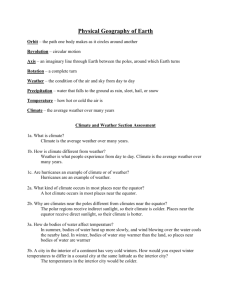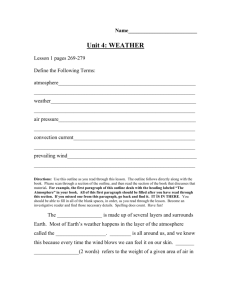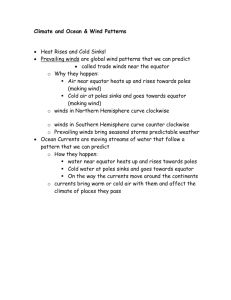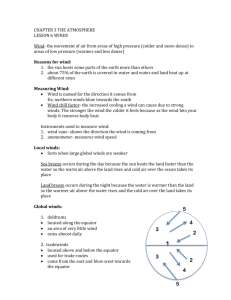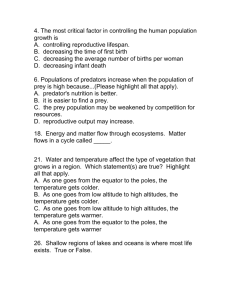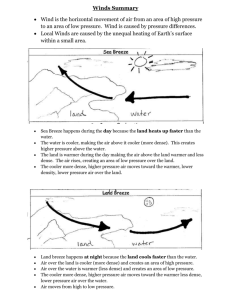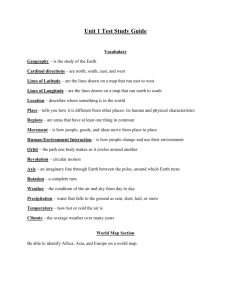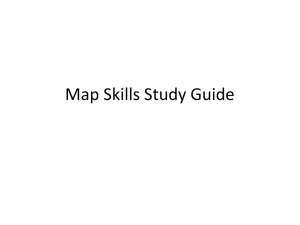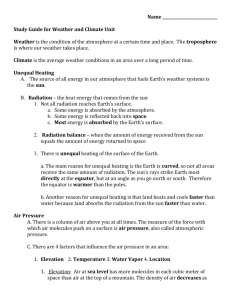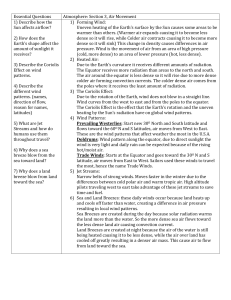Weather and Climate Powerpoint Part 1 - The Short Report
advertisement
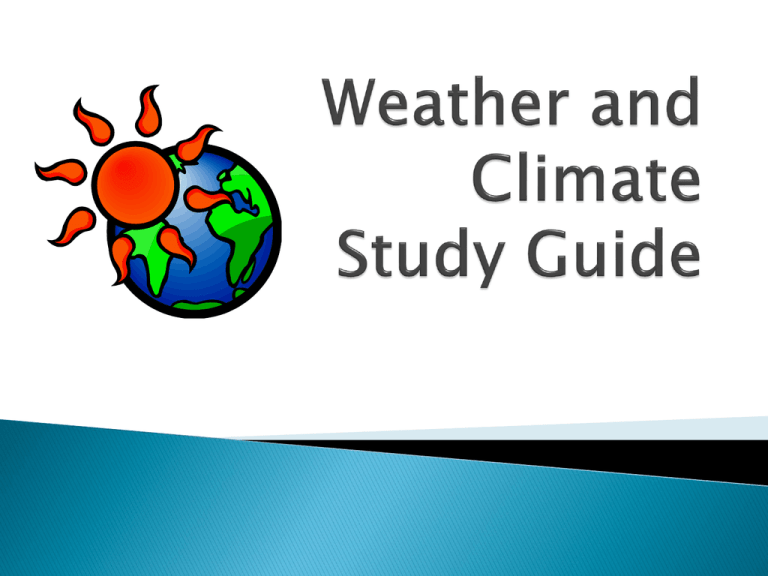
Weather is the condition of the atmosphere at a certain time and place. The troposphere is where our weather takes place. Climate is the average weather conditions in an area over a long period of time. The source of all energy in our atmosphere that fuels Earth’s weather systems is the sun. Radiation – the heat energy that comes from the sun. Not all radiation reaches Earth’s surface. Some energy is absorbed by the atmosphere. Some energy is reflected back into space. Most energy is absorbed by the Earth’s surface. Radiation balance – when the amount of energy received from the sun equals the amount of energy returned to space a. The main reason for unequal heating is the Earth is curved, so not all areas receive the same amount of radiation. The sun’s rays strike Earth most directly at the equator, but at an angle as you go north or south. Therefore the equator is warmer than the poles. Globe with Flashlight Demo. 1. Hold the flashlight a few inches from the globe aiming directly at the equator. 2. Hold the flashlight a few inches from the globe aiming at the poles. *How does this show that the Poles will always be cooler than the Equator? b. Another reason for unequal heating is that land heats and cools faster than water because land absorbs the radiation from the sun faster than water. Land/Water Demo. Only the surface of land absorbs heat (through conduction). This is faster. Water absorbs heat throughout (through convection). This takes much longer. There is a column of air above you at all times. The measure of the force with which air molecules push on a surface is air pressure, also called atmospheric pressure. https://www.youtube.com/watch?v=Bv_tS6qCJ4 B. There are 4 factors that influence the air pressure in an area: 1. 2. 3. 4. Elevation Temperature Water Vapor Location Air at sea level has more molecules in each cubic meter of space than air at the top of a mountain. The density of air decreases as altitude increases. Atmospheric pressure is greatest near Earth’s surface and decreases as you move upward away from sea level. Have you ever felt your ears “pop”? People are not built for sudden air pressure changes. As people go up, the outside pressure decreases. As people move down, the outside pressure increases. The colder the air, the more the molecules move toward one another. Colder air is more dense. More dense air pushes down and has a higher air pressure than warm air. The warmer the air, the more the molecules move apart. Warmer air is less dense. Less dense air rises upward and has lower air pressure than colder air. More water vapor in air has less air pressure because part of the space is being taken up by water; therefore there are fewer air molecules per cubic meter of space available to push down. The most important function of the ocean is giving off water vapor into the atmosphere. Air closer to the poles is colder and more dense than air near the equator. Therefore there is more pressure near the poles than at the equator. Places that have similar latitudes (distance from equator) most likely have similar climates. Air moves in large, circular patterns called convection cells. https://www.youtube.com/watch?v=I0C4QR0 OEH0 https://www.youtube.com/watch?v=EkDhlzA -lwI A. Differences in air pressure cause wind. Winds occur because air tends to move from regions of higher air pressure to regions of lower air pressure. Remember the seven dwarfs? “Hi-Low, Hi-Low, that’s how the wind blows!” 1. As warm air becomes less dense it rises. (low pressure) 2. The colder, more dense air pushes down (high pressure) and rushes in to take the rising, warm air’s place. 3. Winds are named from where they started or came from. What winds are prevailing over the United States? Local winds are temporary winds that blow in an area and are produced by temperature differences caused by local geographical features. Ex: Sea and Land breezes a. Land heats up during the day b. Air over land gets warmer than air over water c. warm air over land rises, while cooler, more dense air from over water rushes in to take its place a. Land cools down at night b. Air over land gets cooler than air over water c. Warmer air over ocean rises while cooler, more dense air from over land rushes in to take its place (Example: Before sunrise on the beach, air over water is warmer than air over land.) Observe an animation of land and sea breezes. A. Global winds blow almost constantly in every direction. 1. Air above the poles is very cold (higher density and higher pressure). 2. Air above the equator is warmer (less density and lower pressure). 3. The lower pressure warm air rises and the higher pressure cold air sinks and rushes toward the lower pressure areas (equator). 4. The rising, low pressure air at the equator is pushed toward the poles creating global winds. http://www.mhhe.com/biosci/genbio/tlw3/eBridge/Chp29/animations/ch29/ global_wind_circulation.swf Observe an animation of the Coriolis effect over Earth's surface. ://www.nasa.gov/mov/142348main_coriolisef fect_hi.mov D. Jet stream - fast moving, narrow belt of wind that has a great impact on changing weather conditions because it determines major air movements. Air mass - large body of air that gets its temperature and humidity from the land or water over which it forms The cause of changes in the weather is when air masses move and meet.
